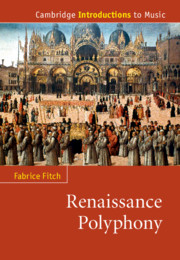Book contents
- Cambridge Introductions to Music
- Cambridge Introductions to Music Renaissance Polyphony
- Copyright page
- Dedication
- Contents
- Illustrations
- Figures
- Tables
- Music examples
- Acknowledgements
- Note on the music examples
- Note on the bibliography
- Abbreviations
- Chapter 1 Introducing Renaissance polyphony
- Chapter 2 Making polyphony: sources and practice
- Chapter 3 Makers of polyphony
- Chapter 4 Pitch: an overview
- Chapter 5 Voice-names, ranges, and functions
- Chapter 6 Mensural notation, duration, and metre
- Chapter 7 Genre, texts, forms
- Chapter 8 ‘Cantus magnus’: music for the Mass
- Chapter 9 ‘Cantus mediocris’: the motet
- Chapter 10 ‘Cantus parvus’: secular music
- Chapter 11 Scoring, texture, scale
- Chapter 12 Understanding musical borrowing
- Chapter 13 Canons, puzzles, games
- Chapter 14 Performance practice: a brief introduction
- Notes
- Glossary
- Bibliography
- Index of compositions
- General index
- Cambridge Introductions to Music
Chapter 5 - Voice-names, ranges, and functions
Published online by Cambridge University Press: 13 August 2020
- Cambridge Introductions to Music
- Cambridge Introductions to Music Renaissance Polyphony
- Copyright page
- Dedication
- Contents
- Illustrations
- Figures
- Tables
- Music examples
- Acknowledgements
- Note on the music examples
- Note on the bibliography
- Abbreviations
- Chapter 1 Introducing Renaissance polyphony
- Chapter 2 Making polyphony: sources and practice
- Chapter 3 Makers of polyphony
- Chapter 4 Pitch: an overview
- Chapter 5 Voice-names, ranges, and functions
- Chapter 6 Mensural notation, duration, and metre
- Chapter 7 Genre, texts, forms
- Chapter 8 ‘Cantus magnus’: music for the Mass
- Chapter 9 ‘Cantus mediocris’: the motet
- Chapter 10 ‘Cantus parvus’: secular music
- Chapter 11 Scoring, texture, scale
- Chapter 12 Understanding musical borrowing
- Chapter 13 Canons, puzzles, games
- Chapter 14 Performance practice: a brief introduction
- Notes
- Glossary
- Bibliography
- Index of compositions
- General index
- Cambridge Introductions to Music
Summary
The discussion of cadence in Chapter 4 leads to a consideration of voice-names, ranges, and functions as key compositional and stylistic determinants. The discantus/tenor relationship constitutes polyphony’s fundamental framework; the nomenclature, ranges, and functions of the voices surrounding it condition the evolution of musical style during the Renaissance. This chapter traces the changes in these parameters to c.1600, showing their audible impact on musical style. At their heart are two fundamental shifts, the first from a texture comprising two registral tiers in the early fifteenth century to the three-tier setup first introduced to continental polyphony c.1440 with the dissemination of the English ‘Missa Caput’, and the second during the last quarter of the century with the emergence of a four-voice texture with a separate range for each voice. The stylistic implications of these devopments are considered in detail, continuing into the next century with the stabilization of the handling of texture into a typology of mode, range, and polyphony, independent of the number of voices present.
- Type
- Chapter
- Information
- Renaissance Polyphony , pp. 66 - 82Publisher: Cambridge University PressPrint publication year: 2020

